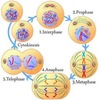Cells and Organelles Flashcards
The bilateral of a cell membrane is a …… ?
Lipid
What is involved in signal transduction and transportation of substances to the cell?
Proteins
Cytoplasm
Contains network for support and organelles Cytoskeleton
Endoplasmic Reticulum
-rough
-smooth
no ribosomes
Made of flat sacs, canals, vesicles, involved in transportation of molecules within the cell and protein synthesis. Rough: covered by Ribosomes Smooth: no ribosomes, used for lipid synthesis
Ribosome
Attached to rough ER. Involved in protein synthesis Provides enzymes and support
Golgi apparatus
Packages/delivers proteins made by ribosomes Exocytosis: when they leave the cell
Mitochondria
Powerhouse of the cell Releases ATP Multi folded w/ enzymes
Lysosome
Enzyme filled sacs used for getting rid of or breaking down nutrients
Peroxisome
Houses enzymes for catalysis of biochemical rxns
Microtubules/microfilaments
Forms cytoskeleton Filaments are proteins bundled, tubules are bigger
Centrioles/centrosomes
Near Golgi body, no membrane, Transfer chromosomes during mitosis
Cilia/flagella
Cilia: short, ordered, precise movement
Flagella: long, random, singular
Vesicles
Vacuoles, used for transport of liquid or solids
Stores water and wastes, is very large in plant cells
Vacuoles
Nucleus
Control center of the cell that contains chromosomes made up of DNA
Nucleolus
Found in nucleus and makes ribosomes that migrate to the cytoplasm
made of RNA and protein, no membrane
Bacteria are an example of this type of cell
Prokaryotic
A cell with a nucleus and other organelles that can be seen
Eukaryotic
Cell membrane
Surrounds cellular contents Thin, flexible, Semi permeable Regulates movement of substances in/out of cell
Chromatin
Loosely coiled DNA and protein (chromosomes)


